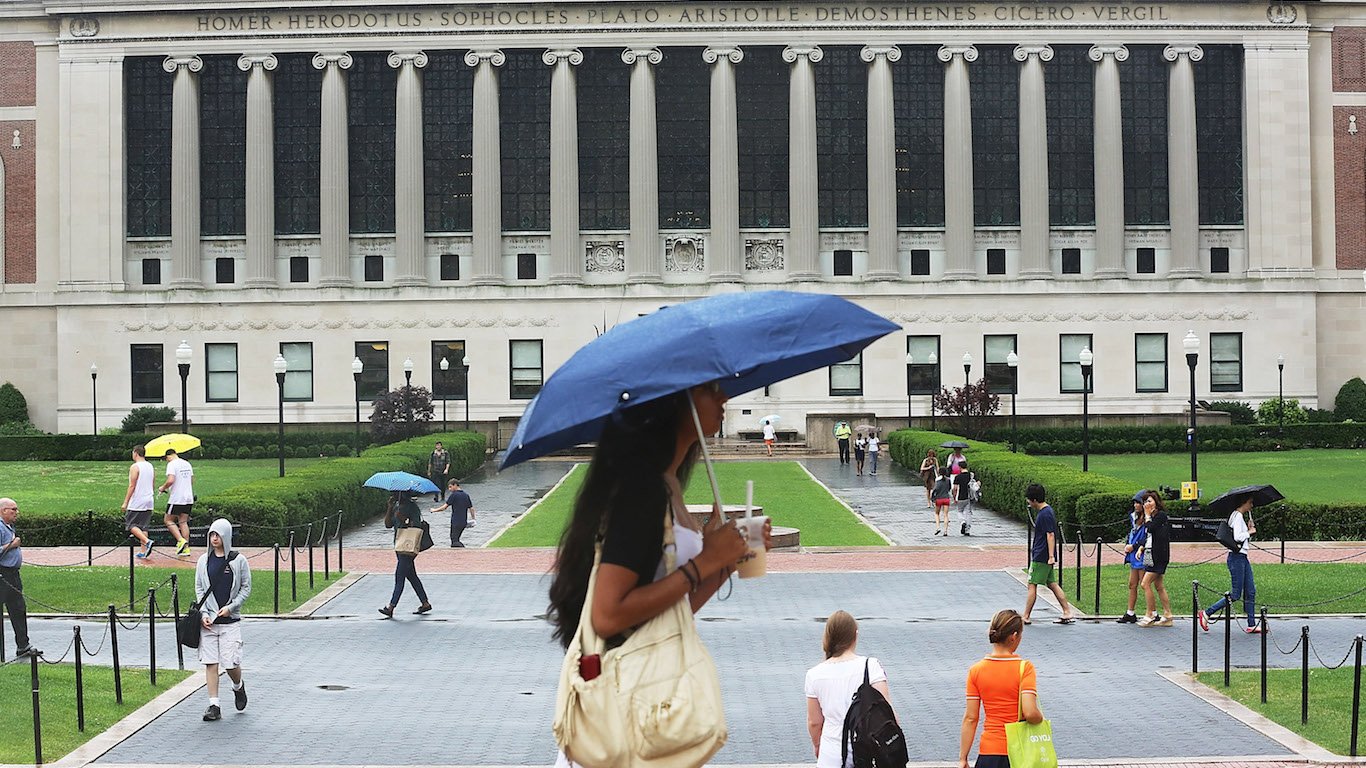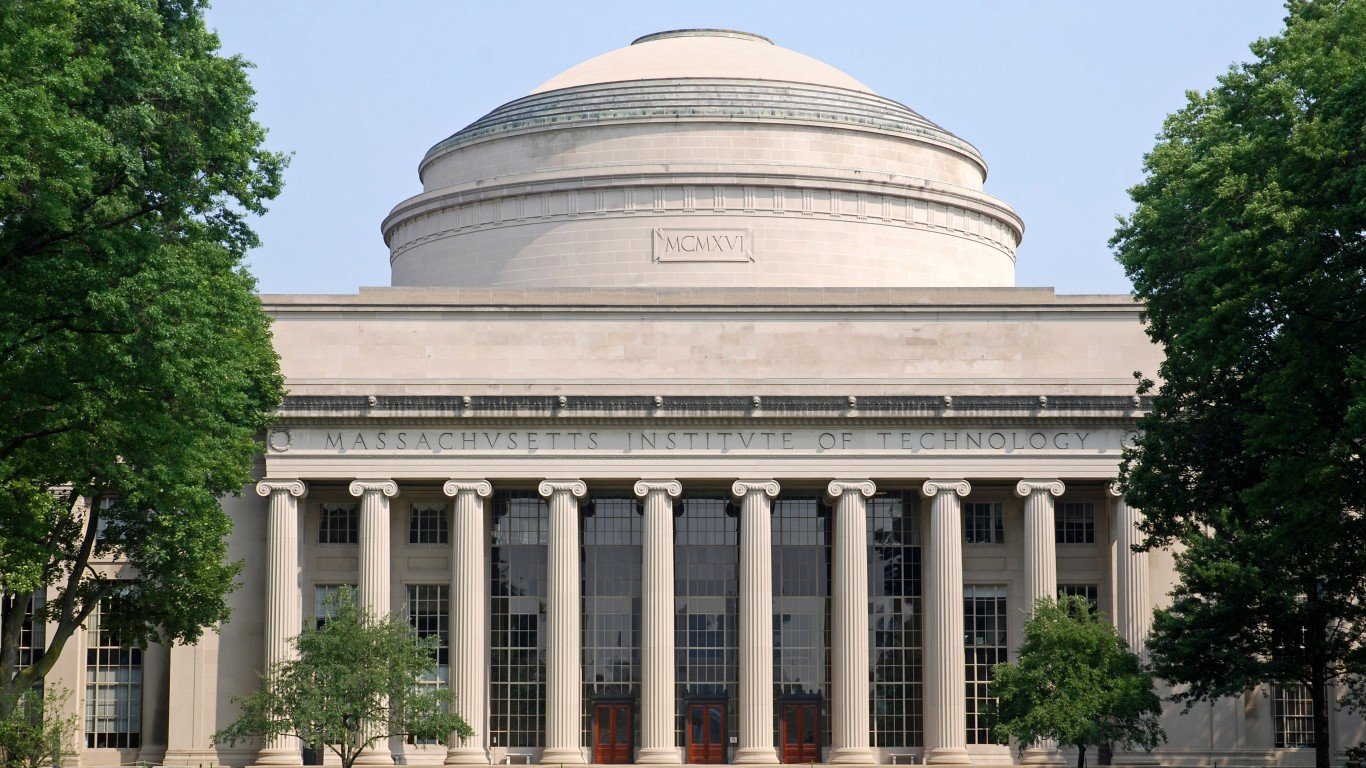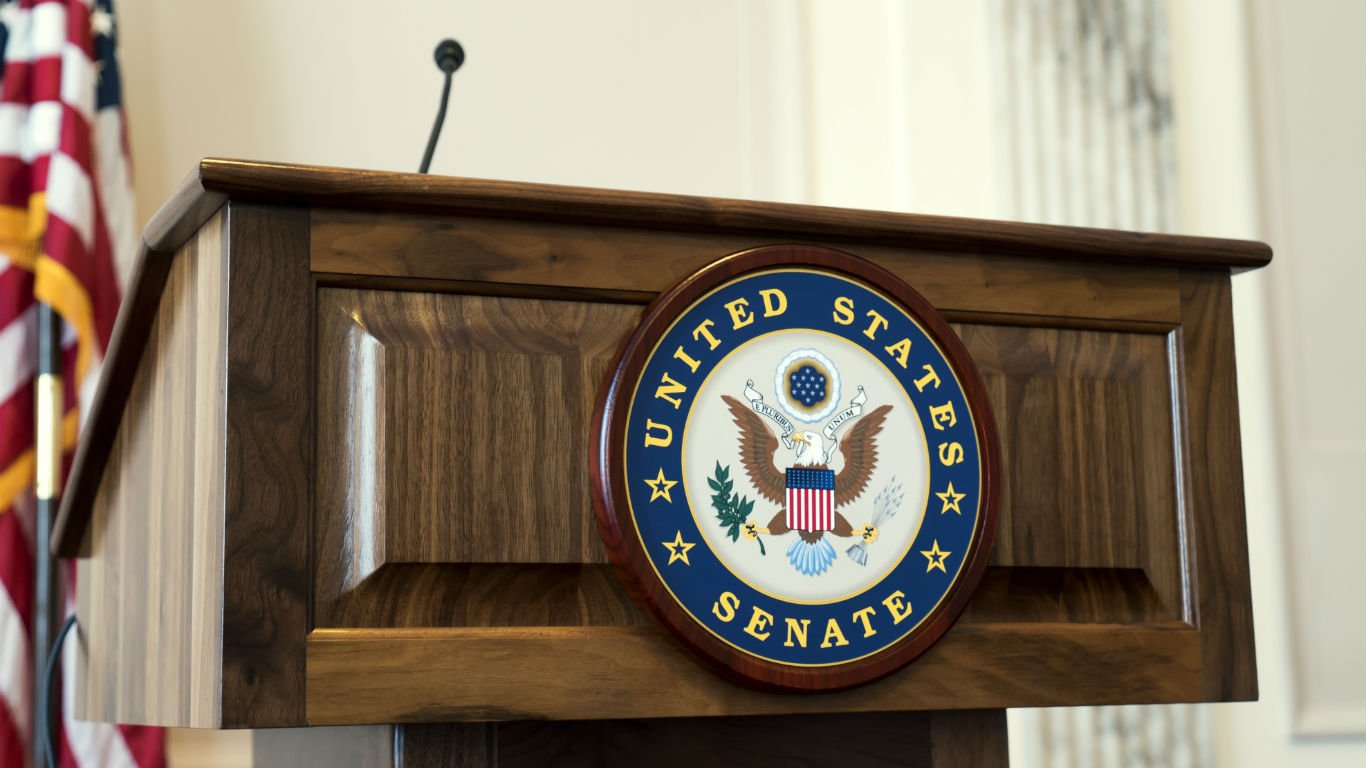

Student loan debt in America reached $1 trillion in 2012 — 54 years after passage of the National Defense Education Act of 1958, the country’s first federally supported student loan initiative. By 2019, just nine years later, that amount had risen to more than $1.7 trillion — an amount expected to keep increasing without legislative intervention.
A federal COVID-19 relief measure has temporarily suspended repayment of student loans, but according to EducationData.org, the average student loan debt for graduates of the Class of 2021 stands at $36,900, with an average monthly minimum payment (when resumed) of $433. That marks a 76% increase over the amount owed by members of the Class of 2000. Since 2013 alone, the total national student loan debt load has ballooned by over 600%. (Consider what it costs to attend the most expensive college in every state.)
This sharp rise in the cost of higher education has burdened millions of recent college graduates and young working adults with a level of debt that can delay important life decisions. Buying a home, investing for retirement, starting a business, saving for rainy days, or simply having money to spend on goods and services remain out of reach for many.
Most people simply live with their student loan debt until they finally pay it off, well into their 30s or 40s or beyond. According to data from StudentAid.gov, 14.2 million student loan debtors between the ages of 35 and 49 owe a total of $602 billion. Another $349 billion is owed by people 50 years or older.
Click here to see the states where people struggle most with student loan debt.
Borrowers can default on their monthly student loan payments and risk having their debt go into collections for different reasons, but one of the most important is the lack of employment opportunities that match their educational and professional histories. These are the cities losing the most jobs in every state.
This list reveals how the total amounts owed and the amounts in collections vary from state to state.
To identify the states with the most student loan debt in collections, 24/7 Wall St. reviewed the share of people with a credit report in each state who have student debt in collections from “Debt in America 2021,” a report by the Urban Institute, based on credit bureau data from 2020. The share of student debt in collections is the percentage of total individuals with any form of student debt that is open, deferred, and sent out to a collection agency.

50. Wyoming
> Median student debt in default: $5,746
> Adults with student debt in default: 8.1% — 11th lowest
> Average overall debt of graduates: $23,444 — 5th lowest
[in-text-ad]

49. Utah
> Median student debt in default: $8,961
> Adults with student debt in default: 8.8% — 14th lowest
> Average overall debt of graduates: $17,935 — the lowest

48. Kansas
> Median student debt in default: $9,957
> Adults with student debt in default: 11.5% — 17th highest
> Average overall debt of graduates: $26,788 — 18th lowest

47. Oklahoma
> Median student debt in default: $10,066
> Adults with student debt in default: 14.3% — the highest
> Average overall debt of graduates: $25,793 — 11th lowest
[in-text-ad-2]

46. New Mexico
> Median student debt in default: $10,081
> Adults with student debt in default: 13.5% — 4th highest
> Average overall debt of graduates: $20,991 — 2nd lowest

45. Nevada
> Median student debt in default: $10,338
> Adults with student debt in default: 14.1% — 2nd highest
> Average overall debt of graduates: $21,254 — 3rd lowest
[in-text-ad]

44. Mississippi
> Median student debt in default: $10,436
> Adults with student debt in default: 14.1% — 3rd highest
> Average overall debt of graduates: $31,651 — 12th highest

43. Michigan
> Median student debt in default: $10,464
> Adults with student debt in default: 11.8% — 13th highest
> Average overall debt of graduates: $30,677 — 16th highest

42. Montana
> Median student debt in default: $10,540
> Adults with student debt in default: 10.2% — 24th highest
> Average overall debt of graduates: $27,265 — 20th lowest
[in-text-ad-2]

41. Alabama
> Median student debt in default: $10,814
> Adults with student debt in default: 12.2% — 10th highest
> Average overall debt of graduates: $29,791 — 22nd highest

40. Texas
> Median student debt in default: $10,827
> Adults with student debt in default: 11.0% — 20th highest
> Average overall debt of graduates: $26,951 — 19th lowest
[in-text-ad]

39. Kentucky
> Median student debt in default: $11,149
> Adults with student debt in default: 12.4% — 8th highest
> Average overall debt of graduates: $28,482 — 25th lowest

38. New Hampshire
> Median student debt in default: $11,194
> Adults with student debt in default: 7.3% — 6th lowest
> Average overall debt of graduates: $39,410 — the highest

37. Nebraska
> Median student debt in default: $11,296
> Adults with student debt in default: 6.4% — 3rd lowest
> Average overall debt of graduates: $26,026 — 14th lowest
[in-text-ad-2]

36. Pennsylvania
> Median student debt in default: $11,339
> Adults with student debt in default: 9.8% — 25th highest
> Average overall debt of graduates: $39,027 — 2nd highest

35. Arizona
> Median student debt in default: $11,354
> Adults with student debt in default: 12.1% — 11th highest
> Average overall debt of graduates: $24,712 — 9th lowest
[in-text-ad]

34. Indiana
> Median student debt in default: $11,426
> Adults with student debt in default: 11.8% — 14th highest
> Average overall debt of graduates: $28,112 — 24th lowest

32. California
> Median student debt in default: $11,467
> Adults with student debt in default: 9.7% — 24th lowest
> Average overall debt of graduates: $21,485 — 4th lowest

32. Arkansas
> Median student debt in default: $11,467
> Adults with student debt in default: 12.6% — 7th highest
> Average overall debt of graduates: $26,679 — 17th lowest
[in-text-ad-2]

31. New York
> Median student debt in default: $11,486
> Adults with student debt in default: 8.8% — 16th lowest
> Average overall debt of graduates: $31,155 — 15th highest

30. West Virginia
> Median student debt in default: $11,591
> Adults with student debt in default: 12.8% — 6th highest
> Average overall debt of graduates: $29,272 — 24th highest
[in-text-ad]

29. Rhode Island
> Median student debt in default: $11,630
> Adults with student debt in default: 9.0% — 18th lowest
> Average overall debt of graduates: $37,614 — 4th highest

28. Alaska
> Median student debt in default: $11,644
> Adults with student debt in default: 11.8% — 15th highest
> Average overall debt of graduates: $25,925 — 12th lowest

27. Louisiana
> Median student debt in default: $11,646
> Adults with student debt in default: 12.8% — 5th highest
> Average overall debt of graduates: $25,512 — 10th lowest
[in-text-ad-2]

26. Virginia
> Median student debt in default: $11,678
> Adults with student debt in default: 8.8% — 15th lowest
> Average overall debt of graduates: $30,574 — 17th highest

25. Washington
> Median student debt in default: $11,753
> Adults with student debt in default: 8.5% — 13th lowest
> Average overall debt of graduates: $24,645 — 8th lowest
[in-text-ad]

24. Illinois
> Median student debt in default: $11,777
> Adults with student debt in default: 9.4% — 22nd lowest
> Average overall debt of graduates: $29,666 — 23rd highest

23. Wisconsin
> Median student debt in default: $11,783
> Adults with student debt in default: 8.1% — 10th lowest
> Average overall debt of graduates: $31,550 — 13th highest

22. Georgia
> Median student debt in default: $11,821
> Adults with student debt in default: 11.7% — 16th highest
> Average overall debt of graduates: $28,081 — 23rd lowest
[in-text-ad-2]

21. Florida
> Median student debt in default: $11,985
> Adults with student debt in default: 11.3% — 18th highest
> Average overall debt of graduates: $24,629 — 7th lowest

20. Tennessee
> Median student debt in default: $12,097
> Adults with student debt in default: 12.0% — 12th highest
> Average overall debt of graduates: $27,525 — 21st lowest
[in-text-ad]

19. New Jersey
> Median student debt in default: $12,290
> Adults with student debt in default: 8.2% — 12th lowest
> Average overall debt of graduates: $33,566 — 7th highest

18. Maryland
> Median student debt in default: $12,308
> Adults with student debt in default: 9.8% — 25th lowest
> Average overall debt of graduates: $30,303 — 19th highest

17. Ohio
> Median student debt in default: $12,309
> Adults with student debt in default: 10.8% — 21st highest
> Average overall debt of graduates: $29,886 — 21st highest
[in-text-ad-2]

16. Minnesota
> Median student debt in default: $12,420
> Adults with student debt in default: 6.9% — 5th lowest
> Average overall debt of graduates: $31,856 — 10th highest

15. Massachusetts
> Median student debt in default: $12,670
> Adults with student debt in default: 6.6% — 4th lowest
> Average overall debt of graduates: $33,256 — 8th highest
[in-text-ad]

14. South Carolina
> Median student debt in default: $12,784
> Adults with student debt in default: 12.2% — 9th highest
> Average overall debt of graduates: $31,524 — 14th highest

13. Delaware
> Median student debt in default: $12,799
> Adults with student debt in default: 9.2% — 21st lowest
> Average overall debt of graduates: $37,447 — 5th highest

12. Idaho
> Median student debt in default: $12,808
> Adults with student debt in default: 8.9% — 17th lowest
> Average overall debt of graduates: $25,942 — 13th lowest
[in-text-ad-2]

11. Oregon
> Median student debt in default: $13,254
> Adults with student debt in default: 10.3% — 22nd highest
> Average overall debt of graduates: $27,542 — 22nd lowest

10. Iowa
> Median student debt in default: $13,263
> Adults with student debt in default: 9.1% — 19th lowest
> Average overall debt of graduates: $30,259 — 20th highest
[in-text-ad]

9. North Carolina
> Median student debt in default: $13,269
> Adults with student debt in default: 10.3% — 23rd highest
> Average overall debt of graduates: $26,583 — 16th lowest

8. Missouri
> Median student debt in default: $13,336
> Adults with student debt in default: 11.0% — 19th highest
> Average overall debt of graduates: $28,740 — 25th highest

7. South Dakota
> Median student debt in default: $13,353
> Adults with student debt in default: 6.4% — 2nd lowest
> Average overall debt of graduates: $31,653 — 11th highest
[in-text-ad-2]

6. Connecticut
> Median student debt in default: $13,587
> Adults with student debt in default: 7.9% — 8th lowest
> Average overall debt of graduates: $38,546 — 3rd highest

5. Hawaii
> Median student debt in default: $13,607
> Adults with student debt in default: 9.4% — 23rd lowest
> Average overall debt of graduates: $23,577 — 6th lowest
[in-text-ad]

4. Colorado
> Median student debt in default: $13,726
> Adults with student debt in default: 9.2% — 20th lowest
> Average overall debt of graduates: $26,562 — 15th lowest

3. North Dakota
> Median student debt in default: $13,767
> Adults with student debt in default: 7.9% — 9th lowest
> Average overall debt of graduates: $32,745 — 9th highest

2. Maine
> Median student debt in default: $13,770
> Adults with student debt in default: 7.8% — 7th lowest
> Average overall debt of graduates: $33,591 — 6th highest
[in-text-ad-2]

1. Vermont
> Median student debt in default: $17,237
> Adults with student debt in default: 6.2% — the lowest
> Average overall debt of graduates: $30,566 — 18th highest
Sponsored: Find a Qualified Financial Advisor
Finding a qualified financial advisor doesn’t have to be hard. SmartAsset’s free tool matches you with up to 3 fiduciary financial advisors in your area in 5 minutes. Each advisor has been vetted by SmartAsset and is held to a fiduciary standard to act in your best interests. If you’re ready to be matched with local advisors that can help you achieve your financial goals, get started now.
Thank you for reading! Have some feedback for us?
Contact the 24/7 Wall St. editorial team.
 24/7 Wall St.
24/7 Wall St. 24/7 Wall St.
24/7 Wall St. 24/7 Wall St.
24/7 Wall St.


